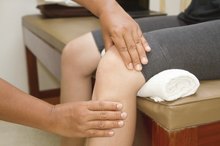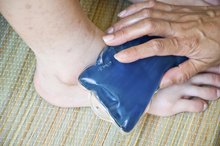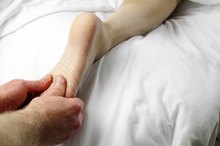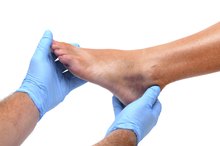What Are the Treatments for a Torn Ligament in the Ankle?
If you've ever sprained your ankle, it's likely you have experience with ligament injury 2. These structures hold bones together throughout your body. Ankle injuries most frequently affect the ligaments on the outside of the ankle.
If you are experiencing serious medical symptoms, seek emergency treatment immediately.
Ankle ligament tear treatment may include a combination of rest, exercise and rehabilitation. Surgery is sometimes needed for severe ankle sprains.
Tips
Depending on the severity of your ligament injury, initial treatment may include anti-inflammatory medication and physical therapy modalities such as ultrasound and electrical stimulation to decrease pain and swelling. As healing progresses, range-of-motion and strengthening exercises are added.
Read more: Signs of a Torn Ligament in the Ankle
Grading Ankle Injuries
Ankle sprains are categorized and treated based on the severity of the ligament injury. Grade 1 sprains involve ligament stretching without obvious tearing. A grade 2 ankle sprain describes a partial ligament tear, and grade 3 sprains involve complete tearing of one or more ankle ligaments.
Ankle Ligament Tear Treatment
How Long Does it Take to Rehab From Meniscus Surgery?
Learn More
Non-steroidal anti-inflammatory medication, such as:
- ibuprofen (Advil
- Motrin)
- naproxen (Aleve) or aspirin
- may alleviate pain
- reduce inflammation during this phase
Elevating your leg as much as possible helps limit and reduce swelling. Your doctor may recommend crutches, a supportive boot, elastic bandage and/or a splint to protect your ankle from further injury.
Interventions in the Subacute Phase
The subacute phase of healing begins around day four and continues until 2 weeks after an ankle ligament injury. During this phase, range-of-motion exercises begin to decrease ankle stiffness caused by swelling. You might receive physical therapy, including ultrasound and electrical stimulation, to help promote healing and exercises to improve your mobility.
Exercises often include drawing the alphabet in the air with your toes, ankle circles, gentle stretches and possibly non-weight-bearing activities, such as riding a stationary bike 1. You might begin to put some weight on your foot as you walk, if approved by your doctor.
- The subacute phase of healing begins around day four and continues until 2 weeks after an ankle ligament injury.
Time to Get Moving
Exercise After Hip Replacement
Learn More
The rehabilitation phase of treatment typically begins once you are able to bear full weight on your ankle and no longer need crutches to walk. This phase may begin 2 to 6 weeks after injury, with more severe ligament tears at the later end of that time frame.
The goal of this phase is to regain movement, strength and function in your ankle. Your physical therapist may stretch your ankle to decrease stiffness and improve movement. Strengthening exercises, such as calf raises, towel toe scrunches and toe marble pick-up, may be performed.
Read more: 12 Easy, Anytime Exercises to Strengthen Your Ankle
- The rehabilitation phase of treatment typically begins once you are able to bear full weight on your ankle and no longer need crutches to walk.
- Your physical therapist may stretch your ankle to decrease stiffness and improve movement.
Restore Full Function
Six weeks after injury and beyond, treatment for ankle ligament tear treatment focuses on returning to full function. Range-of-motion exercises continue with added resistance from an elastic band. Balance training activities, such as standing on an uneven surface and standing only on your injured leg, are also included in treatment. Functional activities might also include sports and recreational activities, jumping and running.
- Six weeks after injury and beyond, treatment for ankle ligament tear treatment focuses on returning to full function.
- Range-of-motion exercises continue with added resistance from an elastic band.
Surgery for Ankle Sprains
Severe grade 3 sprains may require surgery, particularly if you have ongoing pain or consistently feel like your ankle is going to give out. In these situations, your torn ankle ligaments may be reattached with screws. You may have to wear a cast and use crutches for 6 to 8 weeks while the ligament heals. Once the cast is removed, treatment begins at the subacute phase and progresses through the rehab and functional phases.
- Severe grade 3 sprains may require surgery, particularly if you have ongoing pain or consistently feel like your ankle is going to give out.
- You may have to wear a cast and use crutches for 6 to 8 weeks while the ligament heals.
Warnings and Precautions
Seek medical attention if you sprain your ankle, even if you think it's just a minor injury. Early treatment can prevent long-term issues with loss of motion and chronic weakness that can develop after this injury.
Related Articles
References
- American Academy of Orthopaedic Surgeons: "Foot and Ankle Conditioning Program"
- Mayo Clinic: "Sprained Ankle"
- Harvard Health Publishing: "Recovering From An Ankle Sprain"
- Martin R, McGovern R. Managing ankle ligament sprains and tears: current opinion. Open Access J Sports Med. 2016;7:33-42. doi:10.2147/oajsm.s72334
- American Academy of Orthopaedic Surgeons. Sprained Ankle. Updated February 2016.
- Khor YP, Tan KJ. The Anatomic Pattern of Injuries in Acute Inversion Ankle Sprains: A Magnetic Resonance Imaging Study. Orthop J Sports Med. 2013;1(7):2325967113517078. doi:10.1177/2325967113517078
- Dewar RA, Arnold GP, Wang W, Drew TS, Abboud RJ. The effects of wearing an Ankle Stabilizing Orthosis (ASO) Ankle Brace on ankle joints kinetics and kinematics during a basketball rebounding task.Foot (Edinb). 2019 May 7;40:34-38. doi: 10.1016/j.foot.2019.05.003. [Epub ahead of print]
- Mun JU, Cho HR, Sung YJ, Kang KN, Lee J, Joo Y et al. The role of the anterior talofibular ligament area as a morphological parameter of the chronic ankle sprain.J Orthop Sci. 2019 May 16. pii: S0949-2658(19)30129-0. doi: 10.1016/j.jos.2019.05.001. [Epub ahead of print]
Writer Bio
Aubrey Bailey has been writing health-related articles since 2009. Her articles have appeared in ADVANCE for Physical Therapy & Rehab Medicine. She holds a Bachelor of Science in physical therapy and Bachelor of Arts in psychology from the University at Buffalo, as well as a post-professional Doctor of Physical Therapy from Utica College. Dr. Bailey is also a certified hand therapist.









